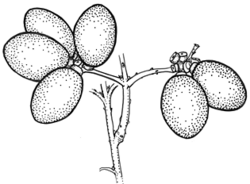
Description: Shrubs or trees, dioecious.
Leaves mostly toothed, fine oil dots numerous and just visible or obscure; shortly petiolate.
Flowers in axillary cymes. Perianth ovoid to globose, nearly closed by 4 tooth-like lobes [or more deeply divided and spreading]. Male flowers with 8–30 stamens. Female flowers with numerous carpels covering the ± flat receptacle, only a few developing into fruit.
Drupes ovoid, c. 15–20 mm long, black, not closely appressed on receptacle surface, sessile or shortly stalked.
Distribution and occurrence: World: 6 species, endemic Australia. Australia: Qld, N.S.W.
Text by G. J. Harden
Taxon concept:
Taxa not yet included in identification key
Wilkiea hugeliana
| | Key to the species | |
| 1 | Leaves with 10–16 pairs of secondary veins, rather thinly leathery; flowers and inflorescence axis silky-pubescent, male flowers 4–5 mm diam., with all 4 perianth lobes duplicated to the inside; stamens c. 30; female flowers 5–7 mm diam | Wilkiea austroqueenslandica |
| Leaves with less than 10 pairs of secondary veins, leathery; flowers and inflorescence axis almost or quite glabrous; male flowers 2–3 mm diam. with only the outer pair of perianth lobes duplicated inside; stamens c. 8; female flowers 3–4 mm diam | 2 |
| 2 | Plants entirely glabrous, leaves very glossy above; finest reticulum usually rather coarse and obscure, but not conspicuously raised; petiole mostly 1–6 mm long, rarely to 10 mm | Wilkiea macrophylla |
| At least the carpels and female receptacle, and often the leaves, hairy; finest reticulum always prominent and raised below even in fresh leaves; petiole usually 6–10 mm long, but shorter in small-leaved plants
Back to 1 | Wilkiea huegeliana |
|


